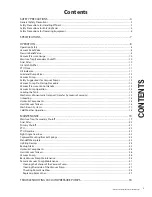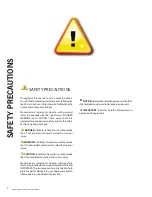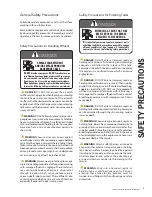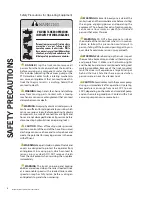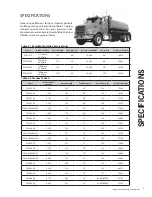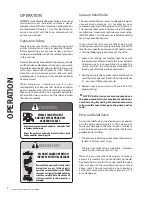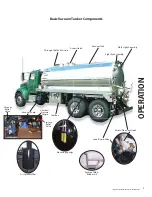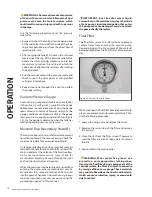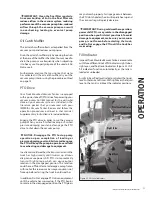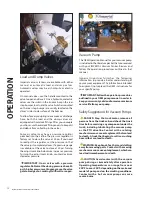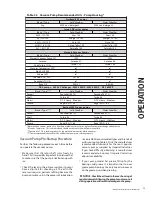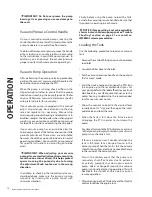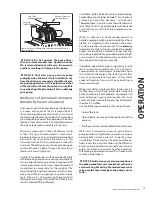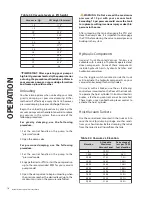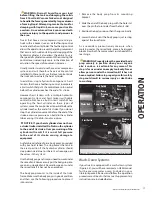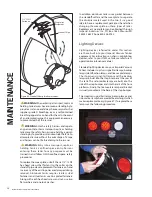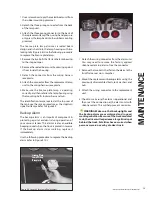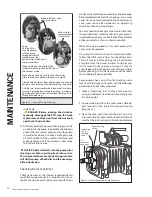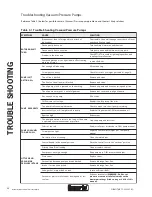
17
IMPERIAL TRUCK MOUNTED VACUUM TANKER MANUAL
1. Remove the body prop from its mounting
bracket.
2. Slide the end of the body prop with the hole in it
over the pin that protrudes from the tank skid.
. Position the body prop so that it hangs vertically.
4. Lower the tank until the body prop is just resting
against the truck frame.
As a secondary precautionary measure when
working under the raised tank, place a hardwood
block across both frame members just ahead of the
rear hinge.
WARNING: Properly place the provided body
prop securely in position when you or anyone
else is under a raised tank for any reason. This
stop is for use under an empty tank only. Never
allow persons under the raised tank if it has not
been emptied. Failure to properly use this safety
stop could result in serious injury or death due
to crushing.
Wash-Down Systems
If your truck is equipped with a wash-down system
(Figure .5), you will have received an OEM manual
for the pressure water pump (included in your
literature packet). Review and follow the operation
procedures outlined in that manual. Supplementary
instructions are included below.
WARNING: Drain all liquid from your load
before lifting the tank and dumping the solids
from it. Your Hoist Vacuum Tanker is not designed
to handle the forces generated by large volumes
of moving liquid. Attempting to raise the tank for
dumping, with liquid in it, can cause your truck to
overturn. An overturned truck can cause death
or serious injury to the operator and persons in
the area.
Trucks that have an air compressor system (e.g. a
truck with air brakes) use an air feathering control
to activate the hoist cylinder. The feathering control
allows the operator to prevent the jerking movement
that occurs with sudden starting and stopping of the
hydraulic cylinder. It also allows the ability to vary
the speed of cylinder movement. When moving the
control lever increasingly more in the direction of
actuation, the speed of movement increases.
Usually, smaller trucks do not have an air compressor
system, and will therefore have a cable control
installed. On these trucks, use the lever control inside
the truck cab to actuate the hoist cylinder.
In addition, single hydraulic-component hoist
tankers, that have a feathering control, incorporate
a limit switch that pulls the control lever into neutral
before the cylinder reaches the end of its stroke.
However, hoist tankers with a multiple hydraulic-
component system and hoist tankers with cable
control Do Not have a built in limit switch. When
operating the hoist cylinder on these types of
systems, move the control lever to neutral before the
cylinder reaches the end of its stroke. If you do not
stop the cylinder movement before the end of the
stroke, excessive pressure can build in the cylinder
tube causing it to distort and/or rupture.
►
NOTICE: If your hoist cylinder does not have
a stroke limiter installed, Do Not run the cylinder
to the end of its stroke. Over pressurizing of the
cylinder will result if it is run at full pressure
to the end of its stroke, causing damage to
equipment.
A safety brace (referred to as a body prop) is provided
with your hoist tanker. The stop braces the tank in
the erect position if the hydraulic cylinder should
creep downward due to inherent oil seepage past
the valves in the system.
Use the body prop anytime you need to work under
the raised tank. However, only put the body prop into
use on an unloaded tank. Never allow persons under
the raised tank if it has not been emptied.
The body prop mounts to the inside of the truck
frame. Make sure the body prop is in good condition,
and then use the following procedure to place it
into service:
OPERA
TION
��������
����
����
�������
�����
������������
����������
����������
Figure 3.5 Washdown Systems: large size, top; small size, bottom
��������
����
������������
����
����

